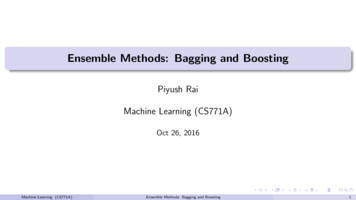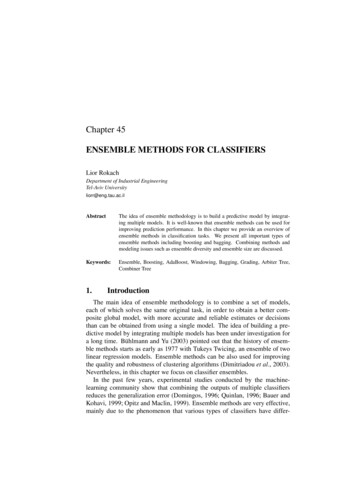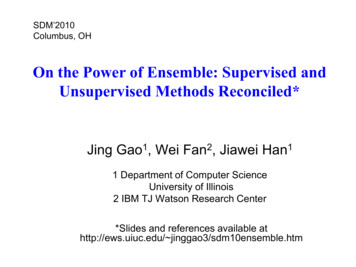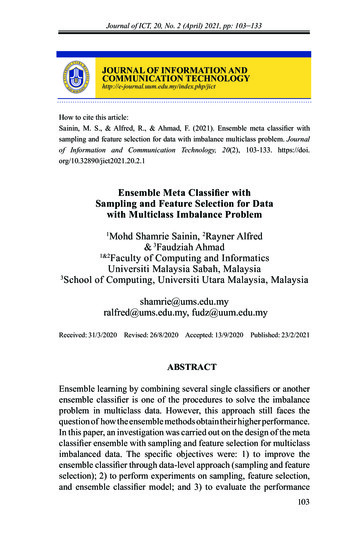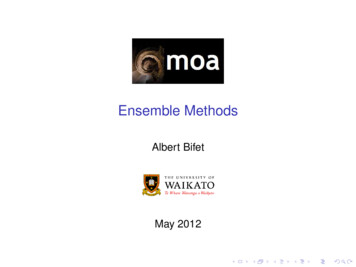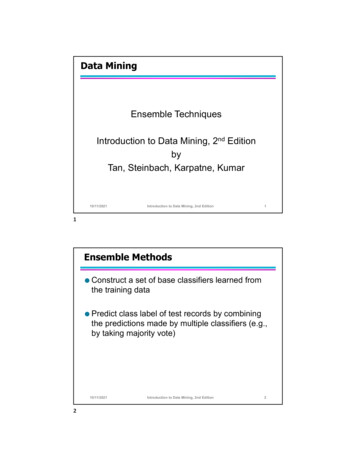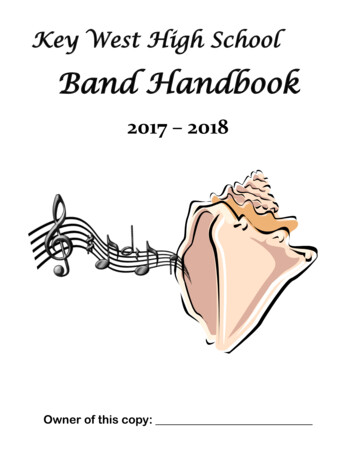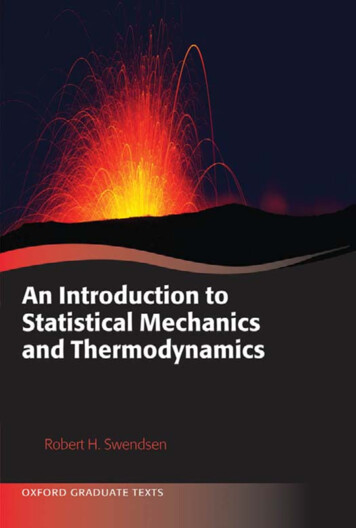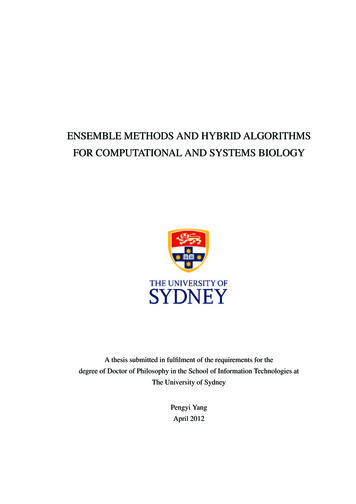
Transcription
ENSEMBLE METHODS AND HYBRID ALGORITHMSFOR COMPUTATIONAL AND SYSTEMS BIOLOGYA thesis submitted in fulfilment of the requirements for thedegree of Doctor of Philosophy in the School of Information Technologies atThe University of SydneyPengyi YangApril 2012
c Copyright by Pengyi Yang 2012All Rights Reservedii
This thesis is dedicated to my parentsMengyi Heng and Xiaofang Yangfor their unconditional and unlimited love and encouragement.iii
AbstractModern molecular biology increasingly relies on the application of high-throughputtechnologies for studying the function, interaction, and integration of genes, proteins, and a variety of other molecules on a large scale. The application of those highthroughput technologies has led to the exponential growth of biological data, makingmodern molecular biology a data-intensive science. Huge effort has been directed tothe development of robust and efficient computational algorithms in order to makesense of these extremely large and complex biological data, giving rise to several interdisciplinary fields, such as computational and systems biology.Machine learning and data mining are disciplines dealing with knowledge discoveryfrom large data, and their application to computational and systems biology has beenextremely fruitful. However, the ever-increasing size and complexity of the biologicaldata require novel computational solutions to be developed. This thesis attempts to contribute to these inter-disciplinary fields by developing and applying different ensemblelearning methods and hybrid algorithms for solving a variety of problems in computational and systems biology. Through the study of different types of data generated froma variety of biological systems using different high-throughput approaches, we demonstrate that ensemble learning methods and hybrid algorithms are general, flexible, andhighly effective tools for computational and systems biology.iv
Statement of OriginalityI hereby certify that this thesis contains no material that has been accepted for the awardof any other degree in any university or other �———————Pengyi YangApril, 2012v
PublicationsMost of the research conducted during my PhD candidature has been published, orsubmitted for publication, in internationally refereed journals, conference proceedings,and invited book chapters. Those materials that contributed significantly to my PhDcandidature are included in this thesis.List of journal publications1. Pengyi Yang, Sean J. Humphrey, Daniel J. Fazakerley, Matthew J. Prior, GuangYang, David E. James, and Jean Yee-Hwa Yang, Re-Fraction: a machine learning approach for deterministic identification of protein homologs and splicevariants in large-scale MS-based proteomics, Journal of Proteome Research,doi: 10.1021/pr300072j, 20122. Pengyi Yang, Jia Ma, Penghao Wang, Yunping Zhu, Bing B. Zhou, Yee HwaYang, Improving X!Tandem on peptide identification from mass spectrometry by self-boosted Percolator, IEEE/ACM Transactions on Computational Biology and Bioinformatics, accepted.3. Penghao Wang, Pengyi Yang, Jean Yee-Hwa Yang, OCAP: An Open Comprehensive Analysis Pipeline for iTRAQ, Bioinformatics, doi: 10.1093/bioinformatics/bts150, 20124. Pengyi Yang1 , Joshua W.K. Ho1 , Yee Hwa Yang, Bing B. Zhou, Gene-geneinteraction filtering with ensemble of filters, BMC Bioinformatics, 12(Suppl1):S10, 20111 equalcontributionvi
5. Pengyi Yang, Yee Hwa Yang, Bing B. Zhou, Albert Y. Zomaya, A review of ensemble methods in bioinformatics, Current Bioinformatics, 5(4):296-308, 20106. Pengyi Yang, Joshua W.K. Ho, Albert Y. Zomaya, Bing B. Zhou, A genetic ensemble approach for gene-gene interaction identification, BMC Bioinformatics, 11:524, 2010 (labeled as “highly accessed” by BMC Bioinformatics)7. Penghao Wang, Pengyi Yang, Jonathan Arthur, Jean Yee Hwa Yang, A dynamicwavelet-based algorithm for pre-processing mass spectrometry data, Bioinformatics, 26(18):2242-2249, 20108. Paul D. Yoo, Yung S. Ho, Jason Ng, Michael Charleston, Nitin K. Saksena,Pengyi Yang, Albert Y. Zomaya, Hierarchical kernel mixture models for theprediction of AIDS disease progression using HIV structural gp120 profiles,BMC Genomics, 11:S4, 20109. Pengyi Yang, Zili Zhang, Bing B. Zhou, Albert Y. Zomaya, A clustering basedhybrid system for biomarker selection and sample classification of mass spectrometry data, Neurocomputing, 73:2317-2331, 201010. Pengyi Yang, Bing B. Zhou, Zili Zhang, Albert Y. Zomaya, A multi-filter enhanced genetic ensemble system for gene selection and sample classificationof microarray data, BMC Bioinformatics, 11:S5, 201011. Pengyi Yang, Liang Xu, Bing B. Zhou, Zili Zhang, Albert Y. Zomaya, A particleswarm based hybrid system for imbalanced medical data sampling, BMCGenomics, 10:S34, 200912. Pengyi Yang, Zili Zhang, An embedded two-layer feature selection approachfor microarray data analysis, IEEE Intelligent Informatics Bulletin, 10:24-32,200913. Zili Zhang, Pengyi Yang, Xindong Wu, Chengqi Zhang, An agent-based hybridsystem for microarray data analysis, IEEE Intelligent Systems, 24(5):53-63,200914. Zili Zhang, Pengyi Yang, An ensemble of classifiers with genetic algorithmbased feature selection, IEEE Intelligent Informatics Bulletin, 9:18-24, 2008vii
List of conference publications1. Pengyi Yang, Zili Zhang, Bing B. Zhou, Albert Y. Zomaya, Sample subsets optimization for classifying imbalanced biological data, In: Proceedings of the15th Pacific-Asia Conference on Knowledge Discovery and Data Mining (PAKDD), LNAI 6635, 333-344, 20112. Li Li, Pengyi Yang, Ling Qu, Zili Zhang, Peng Cheng, Genetic algorithm-basedmulti-objective optimisation for QoS-aware web services composition, In:Proceedings of the 4th International Conference on Knowledge Science, Engineering and Management (KSEM), LNAI 6291, 549-554, 20103. Pengyi Yang, Li Tao, Liang Xu, Zili Zhang, Multiagent framework for bio-datamining, In: Proceedings of the Fourth Rough Set and Knowledge Technology(RSKT), LNCS 5589, 200-207, 20094. Pengyi Yang, Zili Zhang, A clustering based hybrid system for mass spectrometry data analysis, In: Proceedings of Pattern Recognition in Bioinformatics (PRIB), LNBI 5265, 98-109, 2008. (This paper won Student Travel Award)5. Pengyi Yang, Zili Zhang, A hybrid approach to selecting susceptible singlenucleotide polymorphisms for complex disease analysis, In: Proceedings ofBioMedical and Engineering Informatics (BMEI), IEEE Press, 214-218, 20086. Pengyi Yang, Zili Zhang, Hybrid methods to select informative gene sets inmicroarray data classification, In: Proceedings of Australian Conference onArtificial Intelligence (AI), LNAI 4830, 811-815, 2007List of invited book chapters1. Pengyi Yang, Yee Hwa Yang, Bing B. Zhou, Albert Y. Zomaya, Stability of feature selection algorithms and ensemble feature selection methods in bioinformatics, In: Biological Knowledge Discovery Handbook: Preprocessing, Miningand Postprocessing of Biological Data, Wiley-Blackwell, John Wiley & Sons Ltd., New Jersey, USA, forthcoming.viii
List of posters1. Pengyi Yang, Penghao Wang, Bing B. Zhou, Yee Hwa Yang, Studying falsepositive identifications in target-decoy search of mass spectrometry-basedproteomics, Human Proteome World Congress 2010 (HUPO), Sydney, Australia2. Pengyi Yang, Bing B. Zhou, A clustering based hybrid system for mass spectrometry data analysis, EII PhD School 2009, University of Queensland, Brisbane, Australia (Highly Commended Award)ix
AcknowledgementsI thank my supervisor, A/Prof. Bing B. Zhou, for his constant support and guidancethroughout my PhD study. Bing has given me much freedom to pursue my own researchinterests. His extremely valuable support has shaped me into a highly motivated personwho is capable of carrying out research independently. My research interests are in thearea of computational biology and bioinformatics; Bing has provided strong supporton the algorithmic and computational aspects that are critical for developing robustand computationally effective algorithms for solving complex biological problems. Inresearch, Bing has always been insightful and keen to understand the fundamentals.Critical thinking is a key requirement that Bing encourages in his students. In everydiscussion I had with Bing, the central element was always the understanding of thebasics of the question. I would like to express my gratitude to Bing for his guidanceand supervision that helped me to realize my full potential in my research.Computational biology is a multi-disciplinary research field. Throughout my PhDstudy, I have received significant help from my associate supervisors, Dr Jean Yee-HwaYang, Prof. David E. James, and Prof. Albert Y. Zomaya. Jean has been the primary person to open the door of computational biology to me. Through Jean, I had thechance to collaborate with statisticians and biologists, which has helped me to develop the ability to work with those from diverse backgrounds. It is also through Jean’ssupervision that I became much more competent in formulating biological problems ina mathematical and analytical way, which is critical in real-world applications, and Iwould like to express my gratitude to Jean for making all this possible. I spent the thirdyear of my PhD study in Prof. David James’ extremely dynamic and active laboratoryin the Garvan Institute of Medical Research. I thank David for providing me with thisunique opportunity to work with biologists and cutting-edge technologies. In particular, I would like to thank Mr Sean Humphrey for patiently teaching me every detail ofmass spectrometry-based proteomics. Through Sean’s help, I had the opportunity tox
learn the details of experiment preparation and cutting-edge mass spectrometry, whichhave greatly strengthened my appreciation and understanding of biological systems andbiotechnologies. During my PhD study, I have participated in several national and international conferences and PhD schools. I owe gratitude to Prof. Albert Y. Zomayawho has always been supportive about my research and made possible my participationin conferences and PhD schools.I had the great honour of working with many excellent collaborators and mentorswho made my PhD study an exceptional learning experience. Particularly, I would liketo thank Dr Joshua W.K. Ho from the Harvard Medical School; Dr Daniel J. Fazakerleyand Dr Matthew Prior from the Garvan Institute of Medical Research; Dr PenghaoWang, Dr Uri Keich, Prof. Cristobal dos Remedios, and Ms Alana Mohammed fromthe University of Sydney; Dr Jie Ma from the Beijing Proteome Research Center; andProf. Zili Zhang from Southwest University.I thank Ms Katie Yang and Dr Joachim Gudmundsson for making my NICTA research a rewarding experience, and I thank Ms Evelyn Riegler, Dr Bernhard Scholz, andProf. Sanjay Chawla for ensuring my study at the University of Sydney was as smoothas possible.I acknowledge the scholarship support of NICTA International Postgraduate Awardand NICTA Research Project Award, and a variety of financial support awarded by theUniversity of Sydney to participate in national and international conferences.Last but not least, I would like to express my greatest gratitude to my parents fortheir everlasting love and support that encouraged me throughout my entire life.xi
ContentsiiiAbstractivStatement of OriginalityvPublicationsviAcknowledgementsxList of TablesxviiList of Figuresxix1 Introduction1.11.21Methods in computational and systems biology . . . . . . . . . . . . .21.1.1Genome-wide association (GWA) studies . . . . . . . . . . . .31.1.2Gene expression microarray . . . . . . . . . . . . . . . . . . .41.1.3Mass spectrometry (MS)-based proteomics . . . . . . . . . . .61.1.4Ensemble methods and hybrid algorithms . . . . . . . . . . . .7Contributions and organization of the thesis . . . . . . . . . . . . . . .72 Ensemble & Hybrid Algorithms in Computational Biology2.12.211Ensemble methods . . . . . . . . . . . . . . . . . . . . . . . . . . . . 122.1.1Ensemble methods for classification . . . . . . . . . . . . . . . 122.1.2Ensemble methods for feature selection . . . . . . . . . . . . . 18Hybrid algorithms . . . . . . . . . . . . . . . . . . . . . . . . . . . . . 25xii
3 Gene-Gene Interaction Filtering283.1Gene-gene interaction in GWA studies . . . . . . . . . . . . . . . . . . 283.2Filtering gene-gene interactions . . . . . . . . . . . . . . . . . . . . . 293.2.1ReliefF algorithm . . . . . . . . . . . . . . . . . . . . . . . . . 303.2.2Tuned ReliefF (TuRF) . . . . . . . . . . . . . . . . . . . . . . 313.2.3Instability of ReliefF-based algorithm . . . . . . . . . . . . . . 323.3Ensemble of filters for gene-gene interaction filtering . . . . . . . . . . 333.4Experiment on simulation and real-world GWA data . . . . . . . . . . . 343.4.1The effect of the sample order dependency . . . . . . . . . . . 353.4.2The origin of the sample order dependency . . . . . . . . . . . 373.4.3Determination of ensemble size . . . . . . . . . . . . . . . . . 383.4.4Ensemble approach to improve success rate in SNP filtering . . 393.5Summary . . . . . . . . . . . . . . . . . . . . . . . . . . . . . . . . . 403.6Software availability . . . . . . . . . . . . . . . . . . . . . . . . . . . 434 Gene-Gene Interaction Identification444.1Combinatorial testing for gene-gene interaction identification . . . . . . 444.2Genetic ensemble hybrid algorithm . . . . . . . . . . . . . . . . . . . . 474.2.1Genetic component . . . . . . . . . . . . . . . . . . . . . . . . 484.2.2Integration functions . . . . . . . . . . . . . . . . . . . . . . . 504.2.3Selecting classifiers . . . . . . . . . . . . . . . . . . . . . . . . 524.3Evaluation datasets . . . . . . . . . . . . . . . . . . . . . . . . . . . . 524.4Evaluation statistics . . . . . . . . . . . . . . . . . . . . . . . . . . . . 534.54.4.1Evaluation statistics for single algorithm . . . . . . . . . . . . . 534.4.2Evaluation statistics for combining algorithms . . . . . . . . . . 54Experiments and results . . . . . . . . . . . . . . . . . . . . . . . . . . 564.5.1Classifier selection for ensemble construction . . . . . . . . . . 564.5.2Simulation results . . . . . . . . . . . . . . . . . . . . . . . . 574.5.3Real-world data application . . . . . . . . . . . . . . . . . . . 654.6Summary . . . . . . . . . . . . . . . . . . . . . . . . . . . . . . . . . 684.7Software availability . . . . . . . . . . . . . . . . . . . . . . . . . . . 705 Gene Sets Selection From Microarray5.171Microarray data from a computational viewpoint . . . . . . . . . . . . 71xiii
5.25.35.45.5Hybrid approach for gene set selection . . . . . . . . . . . . . . . . . . 725.2.1Multiple filter enhanced genetic ensemble . . . . . . . . . . . . 735.2.2Multiple filtering algorithms score mapping . . . . . . . . . . . 75Filters and classifiers . . . . . . . . . . . . . . . . . . . . . . . . . . . 765.3.1Filter algorithms . . . . . . . . . . . . . . . . . . . . . . . . . 775.3.2Classification components . . . . . . . . . . . . . . . . . . . . 78Experiment designs and results . . . . . . . . . . . . . . . . . . . . . . 795.4.1Datasets and data pre-processing . . . . . . . . . . . . . . . . . 795.4.2Implementation . . . . . . . . . . . . . . . . . . . . . . . . . . 805.4.3Results . . . . . . . . . . . . . . . . . . . . . . . . . . . . . . 82Summary . . . . . . . . . . . . . . . . . . . . . . . . . . . . . . . . . 896 Post-processing MS-based Proteomics Data906.1Peptide-spectrum match post-processing . . . . . . . . . . . . . . . . . 906.2Experiment settings and implementations . . . . . . . . . . . . . . . . 936.36.2.1Evaluation datasets . . . . . . . . . . . . . . . . . . . . . . . . 936.2.2Database searching . . . . . . . . . . . . . . . . . . . . . . . . 936.2.3Percolator for X!Tandem search results . . . . . . . . . . . . . 946.2.4Semi-supervised learning on creating training dataset . . . . . . 966.2.5Self-boosted Percolator . . . . . . . . . . . . . . . . . . . . . . 976.2.6Performance comparison on PSM post-processing . . . . . . . 98Results and discussion . . . . . . . . . . . . . . . . . . . . . . . . . . 996.3.1Percolator is sensitive to PSM ranking . . . . . . . . . . . . . . 996.3.2Determining the number of boost runs . . . . . . . . . . . . . . 1006.3.3PSM post-processing . . . . . . . . . . . . . . . . . . . . . . . 1026.3.4Protein identification . . . . . . . . . . . . . . . . . . . . . . . 1036.4Summary . . . . . . . . . . . . . . . . . . . . . . . . . . . . . . . . . 1036.5Software availability . . . . . . . . . . . . . . . . . . . . . . . . . . . 1057 Extracting Complementary Proteomics Biomarkers1067.1Biomarker discovery from MS-based proteomics data . . . . . . . . . . 1067.2Feature correlation and complementary feature selection . . . . . . . . 1077.3A clustering-based hybrid approach . . . . . . . . . . . . . . . . . . . 1097.3.1Filter-based prefiltering . . . . . . . . . . . . . . . . . . . . . . 112xiv
7.47.57.67.3.2k-means clustering . . . . . . . . . . . . . . . . . . . . . . . . 1137.3.3Cluster feature extraction and representative selection . . . . . . 1137.3.4Using genetic ensemble for m/z biomarker identification . . . . 114Evaluation datasets and experiment designs . . . . . . . . . . . . . . . 1147.4.1Datasets . . . . . . . . . . . . . . . . . . . . . . . . . . . . . . 1147.4.2Data pre-processing . . . . . . . . . . . . . . . . . . . . . . . 1177.4.3Results evaluation . . . . . . . . . . . . . . . . . . . . . . . . 117Experimental results . . . . . . . . . . . . . . . . . . . . . . . . . . . 1187.5.1Evaluating k value of k-means clustering . . . . . . . . . . . . 1187.5.2Sample classification . . . . . . . . . . . . . . . . . . . . . . . 1197.5.3Correlation reduction . . . . . . . . . . . . . . . . . . . . . . . 127Discussion and summary . . . . . . . . . . . . . . . . . . . . . . . . . 1298 Conclusions and Future Work1318.1Conclusions of the thesis . . . . . . . . . . . . . . . . . . . . . . . . . 1318.2Future directions . . . . . . . . . . . . . . . . . . . . . . . . . . . . . 133Bibliography135xv
List of Tables3.1Simulated SNP datasets for filtering experiment . . . . . . . . . . . . . 343.2Average cumulative success rate in retaining a functional SNP pair . . . 404.1Genetic algorithm parameter settings. . . . . . . . . . . . . . . . . . . 494.2Simulated SNP datasets for identification experiment . . . . . . . . . . 534.3Functional SNP pair identification for balanced data . . . . . . . . . . . 584.4Functional SNP pair identification for imbalanced data . . . . . . . . . 584.5Combining algorithms for SNP pair identification in balanced data . . . 624.6Combining algorithms for SNP pair identification in imbalanced data . . 624.7Two-factor interaction candidates of AMD . . . . . . . . . . . . . . . . 674.8Three-factor interaction candidates of AMD . . . . . . . . . . . . . . . 674.9SNPs and environmental factors that associated with AMD . . . . . . . 685.1Microarray datasets used for algorithm evaluation. . . . . . . . . . . . . 805.2Parameter setting for genetic ensemble. . . . . . . . . . . . . . . . . . 815.3Classification comparison using Leukemia dataset . . . . . . . . . . . . 835.4Classification comparison using Colon dataset . . . . . . . . . . . . . . 835.5Classification comparison using Liver dataset . . . . . . . . . . . . . . 845.6Classification comparison using MLL dataset . . . . . . . . . . . . . . 845.7Generation of convergence & subset size for MF-GE and GE . . . . . . 865.8Top 5 most frequently selected genes . . . . . . . . . . . . . . . . . . . 886.1Summary of features used by Percolator for X!Tandem search results. . 957.1MS datasets used in evaluation. . . . . . . . . . . . . . . . . . . . . . . 1167.2Error rate comparison on ovarian cancer-WCX2 dataset . . . . . . . . . 1217.3Error rate comparison on ovarian cancer-WCX2-PBSII-a dataset . . . . 1227.4Error rate comparison on ovarian cancer-WCX2-PBSII-b dataset . . . . 123xvi
7.5Error rate comparison on prostate cancer-H4-PBS1 dataset . . . . . . . 1247.6Significance test on error rates . . . . . . . . . . . . . . . . . . . . . . 1267.7Correlation evaluation on selected m/z features . . . . . . . . . . . . . 127xvii
List of Figures1.1Information flow in the cell . . . . . . . . . . . . . . . . . . . . . . . .11.2SNP chip and data structure . . . . . . . . . . . . . . . . . . . . . . . .41.3Gene expression microarray data . . . . . . . . . . . . . . . . . . . . .51.4Protein identification using mass spectrometry . . . . . . . . . . . . . .62.1Hypothesis space partitioning with ensemble of classifiers. . . . . . . . 142.2Ensemble of classifiers using majority voting. . . . . . . . . . . . . . . 152.3Popular ensemble methods. . . . . . . . . . . . . . . . . . . . . . . . . 162.4Categorization of feature selection algorithms . . . . . . . . . . . . . . 202.5Constructing ensemble of filters . . . . . . . . . . . . . . . . . . . . . 222.6Constructing ensemble of wrappers . . . . . . . . . . . . . . . . . . . . 233.1Ensemble of filters . . . . . . . . . . . . . . . . . . . . . . . . . . . . 343.2Stability in SNP filtering . . . . . . . . . . . . . . . . . . . . . . . . . 363.3Number of times a tie-breaking case happens . . . . . . . . . . . . . . 373.4SNP filtering with tie causing samples removed . . . . . . . . . . . . . 383.5Determining the size of ensemble of filters . . . . . . . . . . . . . . . . 393.6Success rate for retaining a functional SNP pair . . . . . . . . . . . . . 413.7Average cumulative success rate of single filter and its ensemble . . . . 424.1Genetic ensemble system . . . . . . . . . . . . . . . . . . . . . . . . . 474.2Selection of base classifiers and ensemble configuration . . . . . . . . . 574.3TPR and FDR estimation of GE at different rank cut-off . . . . . . . . . 594.4TPR and FDR estimation of GE at different frequency cut-off . . . . . . 604.5Power of GE, PIA, MDR, and combination of the three algorithms . . . 645.1Flow chart of the MF-GE hybrid system . . . . . . . . . . . . . . . . . 745.2Multiple filter score mapping example . . . . . . . . . . . . . . . . . . 76xviii
5.3Sample classification comparison . . . . . . . . . . . . . . . . . . . . . 855.4Multi-filter consensus scores . . . . . . . . . . . . . . . . . . . . . . . 865.5Gene subset size and generation of convergence . . . . . . . . . . . . . 876.1PSM rank effect on creating training dataset . . . . . . . . . . . . . . . 976.2Self-boosting of Percolator . . . . . . . . . . . . . . . . . . . . . . . . 1006.3Correlations of PSM rankings from boost runs . . . . . . . . . . . . . . 1016.4Number of accepted PSMs with respect to q-values . . . . . . . . . . . 1026.5Number of accepted proteins and number of assigned PSMs . . . . . . 1047.1The overall work flow of the FCGE hybrid system. . . . . . . . . . . . 1107.2k value evaluation of FCGE hybrid system . . . . . . . . . . . . . . . . 1197.3Average blocking accuracy according to different k values. . . . . . . . 1207.4Correlation evaluation on selected m/z features . . . . . . . . . . . . . 128xix
xx
Chapter 1IntroductionCentral dogma is the classic framework for studying and understanding biological systems and their functions [46]. It loosely divides the information in biological systemsinto three levels, i.e. genes, transcripts, and proteins, in which the information flowsfrom gene to transcript by transcription and from transcript to protein by translation(Figure 1.1). Although there are many other information flows in a variety of biologicalsystems, the studies of genes, transcripts, and proteins and the information flows amongthem have been the most fundamental subjects in molecular biology oteinTranslationFigure 1.1: The biological system of the cell. The information flows from genes (DNA)to transcripts (RNA and mRNA) and to proteins through transcription and translation.1
CHAPTER 1. INTRODUCTION2The collections of all the genes, transcripts, and proteins in a cell, tissue, or organism at a given time or state are commonly referred to as genome, transcriptome,and proteome [6], respectively. With the development and the application of varioushigh-throughput technologies, we are in the era of profiling and interrogating the entire genome, transcriptome, and proteome of a cell, tissue, organism, or even multipleorganisms, giving rise to new emerging research fields such as genomics [39], transcriptomics [16], and proteomics [147] among numerous other “-omics” science. Theexplosion of the biological data generated from -omics studies and the attempt to understand tens of thousands of genes, proteins, and other biological molecules in a systematic way transformed molecular biology into an information-based science that isbest exemplified by the rise of inter-disciplinary fields such as computational biologyand systems biology. The key characteristic of computational and systems biology isthe application of computational techniques and statistical models for the analysis andinterpretation of the huge amount of biological data. The knowledge discovered fromthese data and systems could have significant impact on biology and human welfare.Machine learning and data mining are intelligent computational approaches used toextract information from large datasets and discover relationships. Their applicationto computational and systems biology have been extremely fruitful [111]. Ensemblelearning and hybrid algorithms are intensive studies techniques in machine learningand data mining. The goal of this thesis is to contribute to the fast-growing field ofcomputational and systems biology by designing ensemble learning methods and hybrid algorithms and applying them to solve biological and computational challenges ingenomics, transcriptomics, and proteomics.1.1 Methods in computational and systems biologySystems biology aims to study and understand biological systems in its full scale andcomplexity. It is characterized by using high-throughput technologies to identify andprofile biological systems in high speed and large scales. It relies on computationalmethods for effective data analysis and interpretation. Here we provide a brief introduction on some of the key high-throughput technologies utilized for studying genomics, transcriptomics, and proteomics and the main questions that associated with each ofthem. Specifically, at the genomic level, we introduce genome-wide association (GWA)
1.1. METHODS IN COMPUTATIONAL AND SYSTEMS BIOLOGY3studies, at the transcriptomic level, we focus on microarray-based gene expression profiling, and at the proteomic level, we describe mass spectrometry (MS)-based proteinidentification. These topics are the main focus of our research and are the subjects thatthis thesis is devoted to. They span across genomics and transcriptomics to proteomics,capturing the main aspects of systems biology.1.1.1 Genome-wide association studiesSingle nucleotide polymorphisms (SNPs) are single-base-pair variants on DNA sequences that contribute to the genotype difference among individuals. Genome-wideassociation (GWA) studies are designed to specifically explore SNP genotypes to understand the genetic basis of many common complex diseases [85]. The studies rely onscreening common SNPs and comparing the variations between individuals who havea certain disease (case) from a control population of individuals (control) by adoptinga case-control study design [88]. The rationale is that comparing the SNP genotypes of case and control samples can provide critical insight to the genetic basis and thehereditary aspects of complex diseases. One of the key technologies that enables thegenome-wide screening of SNPs is known as SNP chips [72]. SNP chips interrogatealleles by hybridizing the target DNA to the allele-specific oligonucleotide probes onthe chips [188]. Since a DNA sequence containing a SNP may match perfectly to aprobe-producing a stable hybridization, or be a mismatch to the probe-producing an unstable hybridization, the amount of DNA that could be found in the stable hybridizationis relatively much more abundant than what could be found in unstable hybridization.Based on the amount of hybridization of the target DNA to each of those probes, onecan determine if an allele is homozygous or heterozygous. Figure 1.2 is a schematicillustration of SNP chips. On the SNP chip, each spot corresponds to a SNP site on thegenome. The data obtained from SNP chips is a matrix with each position providinga profiling of the genotype of a SNP as homozygous or heterozygous alleles inheritedfrom the parents [148]. Each row represents a sample that has been genotyped, and thelast column is the class label for the disease status of each sample.GWA studies have been proven to be extremely useful for locating disease associated genes in complex diseases. Some of the most cited studies include the identificationof genes TCF7L2 and SLC30A98, which contribute to the risk of developing type 2diabetes [180], and the identification of genes CFH and ARMS2 as the risk factors for
CHAPTER 1. INTRODUCTION4SNP chipM SNPs t1,Mc1t2,1t2,2 t2,Mc2 t1,2 t1,1 N samplesClass label tN,1tN,2 tN,McN“Heat map”Figure 1.2: A schematic illustration of SNP chip and the data structure. A SNP chipis applied for genotyping and the data matrix obtained is a categorical data matrix witheach variable taking a genotype of AA, AB, or BB corresponding to homozygous orheterozygous alleles. The SNP-disease associations and the SNP-SNP interactions canbe represented as a “heat map” with brighter colours indicating stronger associations.developing age-related macular degeneration [103]. Some of the main computationalchallenges in GWA data analysis include data normalization [31], SNP calling [161],disease-associated SNP identification [87, 142], and gene-gene interaction identification [42, 59]. In particular, the analysis of the hu
Machine learning and data mining are disciplines dealing with knowledge discovery from large data, and their application to computational and systems biology has been extremely fruitful. However, the ever-increasing size andcomplexity of the biological data require novel computational solutions to be developed. This thesis attempts to con-

